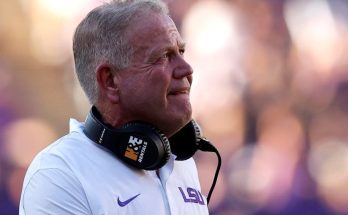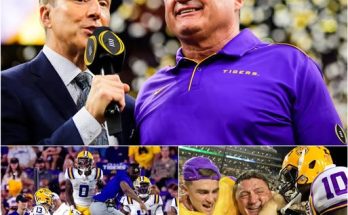In the high-stakes world of college football recruiting, every commitment holds immense weight, shaping the trajectory of a program’s success for years to come. For Penn State, a program steeped in tradition and known for its passionate fan base, the recent loss of a top quarterback recruit to the Auburn Tigers has sent shockwaves throughout the Lion Nation. This unexpected shift not only impacts the immediate depth chart but also raises pressing questions about the program’s recruiting strategies, quarterback development, and future competitiveness in a highly competitive college football landscape.
The commitment of a quarterback is often regarded as the linchpin of a team’s offensive future. Quarterbacks are the architects on the field, commanding playbooks, leading teammates, and often defining the identity of a football program. When a top prospect who had pledged his allegiance to Penn State reverses course and instead commits to Auburn, it deals a blow not just in terms of talent lost but also in recruiting momentum and program perception. This is especially critical in an era where elite quarterbacks are rare commodities and recruiting battles have become fiercely competitive across all conferences.
This particular recruit, a highly rated four-star quarterback, had initially energized the Penn State fan base and coaching staff alike. His skill set—marked by a combination of strong arm talent, athleticism, and football IQ—aligned well with the offensive scheme Penn State envisioned under their coaching regime. His commitment was viewed as a cornerstone piece in the rebuild of the Lion’s offense, promising a future where the team could return to national prominence. The sudden switch to Auburn, a program on the rise in the Southeastern Conference (SEC), reflects the increasingly national nature of recruiting battles, where prospects weigh program culture, coaching stability, competitive opportunities, and exposure on the national stage.
Losing such a key commitment has ripple effects beyond just filling the quarterback spot. Recruiting classes are carefully balanced compositions of positions, talent levels, and team needs. When a quarterback of this caliber is lost, Penn State’s recruiting staff is forced back to the drawing board, scrambling to identify alternative prospects while managing the risk of leaving a critical position thin. The ripple extends to the existing roster, where current quarterbacks may now face heightened pressure to step up or risk a talent gap that could hamper offensive production.
The coaching staff, led by head coach James Franklin, must now pivot quickly to mitigate the impact of this loss. Franklin’s tenure at Penn State has been characterized by strong recruiting and player development, but the quarterback position has often been a challenging area, with the program historically struggling to find a long-term solution at the helm. This latest development intensifies scrutiny on their ability to attract and develop elite signal-callers. The coaching staff will need to double down on recruiting efforts, utilizing relationships, program vision, and recent successes to convince remaining prospects to commit and develop within the Penn State system.
Meanwhile, Auburn’s triumph in securing the commitment of this top quarterback prospect signals a boost for the Tigers as they seek to bolster their offensive firepower and compete at the highest level in the SEC. Auburn’s recruiting pitch likely emphasized the program’s upward trajectory, offensive scheme compatibility, and the allure of competing in arguably the toughest football conference in the country. This addition gives Auburn a critical advantage, potentially reshaping their quarterback room and enhancing their prospects for future seasons.
The loss also highlights the evolving dynamics of college football recruiting, where players have more autonomy than ever before to make decisions based on a broad set of factors, including NIL (Name, Image, and Likeness) opportunities, program culture, coaching staff stability, and playing time potential. Programs like Penn State, traditionally strong in recruiting in the Northeast and Midwest, now face stiff competition from programs like Auburn that offer the promise of the SEC spotlight and a more visible platform for NFL scouting. This shift underscores the importance for Penn State to broaden its recruiting reach, adapt to changing player priorities, and innovate its recruiting approach to stay competitive nationally.
Beyond recruiting, the immediate impact on the team’s on-field performance cannot be overstated. Quarterback is a position where experience and chemistry with the offensive unit are crucial. Losing a quarterback who had been preparing to take a central role means that Penn State may face a transitional period, relying on less experienced players or transferring talent to fill the gap. This scenario often results in growing pains on offense, which can translate into a tougher road during the season and potential challenges in securing bowl games or competing for conference titles.
In addition, the psychological effect on the team and fan base must be considered. Recruiting commitments often energize and unify a program’s community. When a high-profile commitment falls through, it can create uncertainty and disappointment that reverberate beyond the coaching staff to players, supporters, and boosters. It puts pressure on the program to quickly reassure all stakeholders that the path forward remains bright and that new opportunities will arise.
Looking forward, Penn State’s response to this setback will be critical. Historically, the program has weathered recruiting disappointments and rebounded through strong coaching and player development. The immediate priority will be to identify new quarterback prospects, whether through the high school recruiting pipeline or the increasingly prominent transfer portal. The transfer portal, in particular, has become a vital tool for programs looking to quickly address roster gaps and inject experience and talent at critical positions like quarterback.
Moreover, Penn State must continue to build on its broader program strengths—academic prestige, passionate fan base, facilities, and a culture of excellence—to attract talent that not only fits the on-field needs but also embraces the Penn State way of life. The program’s leadership will need to communicate a clear and compelling vision that resonates with recruits and their families, emphasizing stability, development, and a pathway to success both on and off the field.
The loss of the quarterback commit to Auburn also serves as a reminder of the unpredictable and often volatile nature of college football recruiting. It is a high-stakes chess game where every move, every visit, and every conversation can shift the balance. For Penn State, this moment is both a challenge and an opportunity—an impetus to reassess, regroup, and reignite the recruiting engine with renewed focus and urgency.
In conclusion, while losing a top quarterback commit to Auburn is undeniably a significant setback for Penn State football, it is not the end of the story. The program’s resilience, history of overcoming adversity, and strong foundation provide a roadmap for recovery. Success will depend on how swiftly and strategically Penn State can adapt to this change, continue to attract and develop talent, and keep faith with its fan base and players. The road ahead may be rocky, but with the right leadership and determination, the Lions can navigate this dilemma and continue their pursuit of excellence in college football’s competitive landscape.



